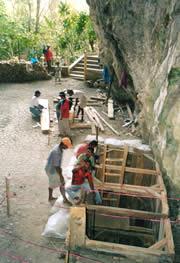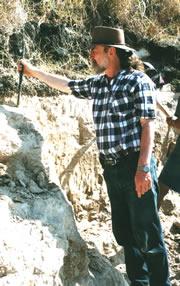What was your initial reaction to the finding?
 Peter Brown led the analysis of the remains found at Liang Bua.© P. Brown
Peter Brown led the analysis of the remains found at Liang Bua.© P. BrownPeter Brown : In early September 2003 Mike Morwood brought the cast of a tooth to my laboratory. It had been recovered from the excavations at Liang Bua. I realized that while it was broadly human it could not have been from a modern human, so it was exciting. More exciting was when Mike announced that the continuing excavations had uncovered a fairly complete skeleton. We quickly arranged to go to Jakarta.
Mike Morwood : The feeling was one of tremendous excitment. We had previously recovered a few very unusual hominid bones and teeth from the Pleistocene levels of Liang Bua, but now we had a major part of a skeleton, including the skull.
How quickly did you realize its importance?
MM : We knew straight away that the finding was important, but because of the size of the skull we initially thought that the individual was a young child. This view changed when [team member] Rokus Awe Due examined the teeth, which were very worn. Later detailed forensic analysis by Peter Brown indicated that she was an adult female aged about 30.
PB : Within a second of seeing the skull and mandible I realized it was important. Mike and Thomas Sutikna (the archaeologist primarily responsible for the day-to-day running of the excavation) report that when I measured the skull's approximate brain size I was clearly in shock. I knew this was the skeleton of a biped, but it had the brain size of a chimpanzee and was alive perhaps as recently as 14,000 years ago. It seemed impossible. Still does!
What had you been hoping to find when you began the dig?
MM : We were hoping to find evidence for the initial arrival of modern humans on the island, and possibly the preceding hominid species - sites further east in the Soa Basin of central Flores had previously shown that hominids were on the island by 840,000 years ago.
So was Homo floresiensis completely out of the blue?
 The team excavating at Liang Bua.© M. Morwood
The team excavating at Liang Bua.© M. MorwoodPB : Yes. The only other hominins of this body and brain size date to the Pliocene epoch [between roughly 7 million and 2 million years ago] in Africa. However, they have very different facial skeletons and teeth to H. floresiensis (smaller teeth and a less projecting face). There are also no other examples of hominins dwarfing in the way that some other mammals often do on islands. We're still not certain that H. floresiensis dwarfed on Flores, as no larger-bodied ancestor has been found.
Who made the actual discovery?
PB : The discovery was made by the archaeological team directed by Mike and R. P. Soejono [of the Indonesian Centre for Archaeology in Jakarta]. At the time the excavation was being led by Thomas Sutikna, who also did a lot of the initial cleaning and conservation of the skeleton. My role was primarily in cleaning, reconstructing and conserving the skull and some other skeletal elements, and then recording and describing the skeleton.
MM : The team was assisted by 35 local manggarai workers. Other researchers dated the finds, and analysed the associated faunal remains and stone artefacts. In fact, the input of specialists from many institutions and disciplines has been crucial to the success of our research.
What's next for human palaeontology? Given its habit of throwing up surprises, is that a silly question?
PB : Until the discovery at Liang Bua the broad pattern of human palaeontology was starting to look predictable - not such a bad thing for those of us who teach the subject. After this discovery, and perhaps an increased focus on island Southeast Asia, I predict a few major surprises ahead. Researchers will start to look a lot more closely at the isolated teeth and jaw fragments recovered from cave deposits on the Asian mainland. Some of these, previously thought to be the remains of a small ape, may turn out to be something else.
 Mike Morwood directed the dig at Liang Bua.© M. Morwood
Mike Morwood directed the dig at Liang Bua.© M. MorwoodMM : My own feeling is that future archaeological discoveries in Southeast Asia will show that human dispersal and cultural change were much more complex than previously believed, and that Asia may have played a much more prominent role in these issues than adherents of the simplistic 'Out of Africa' explanation for everything would have us believe.
Does this change your own feelings about the uniqueness and modernity of Homo sapiens?
PB : Yes and no. Although it was a member of our genus, H. floresiensis is unlikely to have contributed to the gene pool of H. sapiens. So for me, its importance is not in the evolutionary story of modern humans, but in how the broad group from which modern humans evolved may have adapted and evolved to different ecosystems. Prior to this finding it would not have been thought that a hominin with the brain size, and possibly limited cognitive ability, of H. floresiensis could make the type of tools associated with the skeleton, or even get to Flores at all. I suppose that this is what challenges existing notions of what it is to be human the most.
